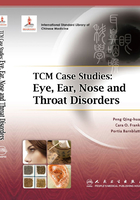
上QQ阅读APP看书,第一时间看更新
COMMENTARY AND DISCUSSION
In TCM, ptosis is called shàng bāo xià chuí (drooping of the upper eyelid). When treating this case, the physician triages the symptoms, first focusing on the acute, branch symptoms and afterwards, treating the root causative factors. This reemphasizes a basic principle of treatment familiar to all practitioners of Chinese medicine.
The modern physician Qin Bo-wei has written extensively on his methodology for diagnosing and treating diseases. One fundamental equation that he frequently applied to organizing clinical data was: Disease factor + Location + Symptoms = Patern = Formula. 2 When reading these case histories, the similarities between Qin and this physician are striking. By following this algorithm, differentiation and formula selection for this case might look like this:
Disease Factor: wind phlegm and qi defciency +
Location: the eyelid or muscle wheel +
Symptoms: sudden ptosis, fatigue, dizziness =
Patern: wind phlegm blocking the collaterals with qi defciency =
Formula: Modifed Zhèng Róng Tāng (Face-Righting Decoction)
The focus of the formula for the first week of treatment consists of a variety of wind-expelling, phlegm-transforming and blood-invigorating medicinals. Fáng fēng, qiāng huó and qín jiāo are also used together in the formula Dà Qín Jiāo Tāng (Large Gentian Decoction). This formula from the Collection of Writings on the Mechanism ofDisease, Suitability of Qi, and the Safeguarding of Life as Discussed in the ‘Basic Questions’( Sù Wèn Bìng Jī Qì Yí Băo Mìng Jí, 素问病机气宜保命集) is similar in function to ZhèngRóng Tāng in that they both treat wind afecting the channels; however, Zhèng Róng Tāng emphasizes medicinals that resolve phlegm and invigorate the blood, while DàQín Jiāo Tāng eliminates wind and nourishes the blood.
Bái fù zĭ and bái jiāng cán (Bombyx Batryticatus) are also paired in the formula Qiān Zhèng Săn (Symmetry-Correcting Powder), which uses strong wind expelling, phlegm resolving agents. Zhì bàn xià completes this group. Hóng huā and chì sháo are a common combination used in numerous formulas for treating blood stasis. Mù guā and sōng jié (Lignum Pini Nodi) are teamed in Gŏu Pí Gāo (Dog Skin Plaster) which is a topical preparation for treating bì syndromes as well as the medicinal wine Hŭ GŭJiŭ (Tiger Bone Wine). Mù guā is commonly used to relieve spasms and harmonize the stomach. Sōng jié (Lignum Pini Nodi) is used to expel wind dampness and relieve pain in the body. Both medicinals are warm and enter the liver channel. When combined with medicinals that eliminate wind in the upper body and invigorate the channels and collaterals, they alleviate muscular tension.
At the second visit, the doctor shifts his attention to treating qi deficiency by adding huáng qí to the formula. Dān shēn is added to harmonize the blood.
Of equal importance in this case is the acupuncture treatment. The point combination is simple and direct, using no more than 5-6 points per treatment; most of the points are treating the root paterns. The points can be grouped this way:
GB 20 ( fēng chí) and LV 3 ( tài chōng) eliminate wind.
ST 40 ( fēng lóng) resolves phlegm.
BL 62 ( shēn mài) is the opening point of the yáng qiāo mài. Its trajectory reaches to BL 1 ( jīng míng), and thus is an important point for eye disorders.
SP 10 ( xuè hăi) invigorates the blood to help eliminate wind.
LI 4 ( hé gŭ) expels wind and is considered to be a controlling point for disorders of the face.
BL 2 ( cuán zhú) and SJ 23 ( sī zhú kōng) are the only local points used.